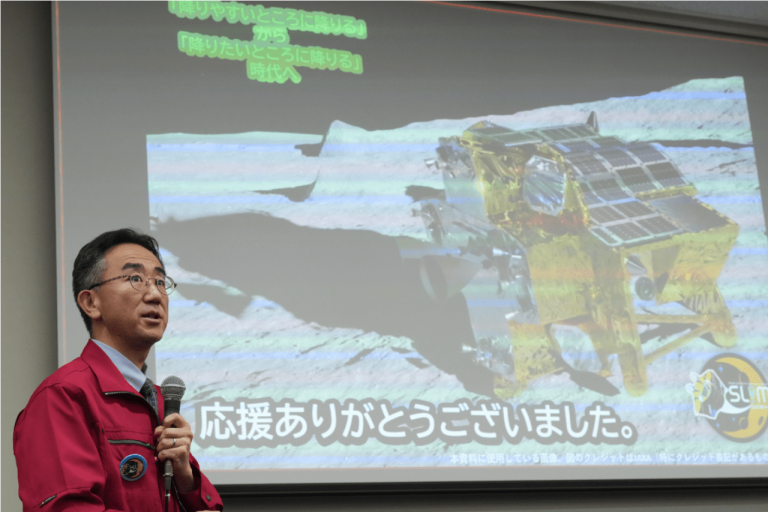On January 19, shortly after the Astrobotic Peregrine spacecraft reached its fiery end upon re-entry into Earth's atmosphere in the Pacific sky, the Japan Aerospace Exploration Agency, or JAXA, SLIM lunar lander attempted a landing on the Moon.
The good news is that SLIM carried out the landing successfully. Ground stations received good telemetry from the lunar lander. Two small rovers called Lunar Excursion Vehicle 1 – LEV-1 – and Lunar Excursion Vehicle 2 – LEV-2 – which were ejected from SLIM, also sent data.
The bad news is that SLIM's solar panels failed to capture energy from the sun. Because SLIM was running solely on battery power, flight controllers had to turn off the lander after a few hours. The Japanese hope that when the sun is at a perfect angle above the moon's surface, the solar panels will start generating power again, allowing the flight controllers to wake SLIM from their slumber.
The Japan Aerospace Exploration Agency (JAXA) has announced more good news/bad news. SLIM's precision landing technology has proven itself. This will have implications for the Artemis program by giving the spacecraft the ability to land where it is needed, not just where it is easy to land. When NASA and its international and commercial partners establish a lunar base, precision landing will be a critical technology.
The bad news is that because one of the SLIM engines failed during the final descent, the lander fell on its nose. The Japan Aerospace Exploration Agency released an image taken by the LEV-2 lander showing the lander's current location on the lunar surface. If JAXA can get SLIM's solar panels to work, it could also achieve many, if not all, of the mission's science goals.
In any case, Japan has now become the fifth country to successfully land on the moon, after the United States, the Soviet Union, China, and most recently India.
Through its participation in the International Space Station, the Kaguya lunar lander, and the Hayabusa asteroid mission, among other achievements, Japan has established itself as a major space power.
The country is likely to expand its role as a player in space exploration. In late 2023, The Japan Times reported that NASA and JAXA were negotiating an agreement that would include a Japanese astronaut on a future Artemis mission on the moon. Japan was actually one of the first signatories to the Artemis Accords, an agreement that stipulates rules for operating on other celestial bodies such as the Moon. Japan will also participate in the construction of Gateway, the lunar orbital space station that NASA is planning as part of the Artemis program.
While the Japanese work to bring the SLIM lunar lander back to life, Texas-based Intuitive Machines is preparing to launch the lunar lander, Nova-C, sometime in mid-February. Intuitive Machines Nova-C is the second American lunar landing attempt under the Commercial Lunar Payload Systems Program after the failed Astrobotic Peregrine mission. In the words of former NASA Administrator Jim Bridenstine, the mission is “another shot on the target” to return America to the moon.
According to NASA, the mission's goal is to place Nova-C “in Malapert A crater near the Moon's south pole.” Nova-C will carry “five NASA payloads and commercial cargo.” Other goals include “studies of plume-surface interactions, radio astronomy and space weather interactions with the lunar surface,” and “demonstrating precise landing techniques and communications and navigation node capabilities.”
According to Rebecca Boyle, author of Our Moon: How Earth's Celestial Companion Transformed the Planet, Directed Evolution, and Made Us Who We Are, the coming arrival of commercial robots on the moon would change humanity's relationship with our closest neighbors forever. Very soon, humans will be living and working on the Moon, engaging in scientific exploration and accessing its resources for the betterment of human civilization.

Boyle believes that a discussion should be had about what we should do on the Moon before it is too late. Considering that 45 years passed between the Apollo 17 mission and the beginning of the Artemis program, it has already been a long time for such a discussion. The decision makers will be those who are willing to invest the capital and effort to return to the Moon. The Artemis Accords are the result of efforts to organize a return to the Moon,
Soon, people will walk on the moon, making the moon a new frontier for human endeavor.
Posted by Mark R. Whittington, who writes frequently about space policy, wrote a political study on space exploration entitled “Why is it difficult to return to the moon?” Beside “The moon, Mars and beyond“And the last one”Why is America returning to the moon?“He blogs in Homeless Corner.
Copyright 2023 Nexstar Media Inc. all rights are save. This material may not be published, broadcast, rewritten or redistributed.

